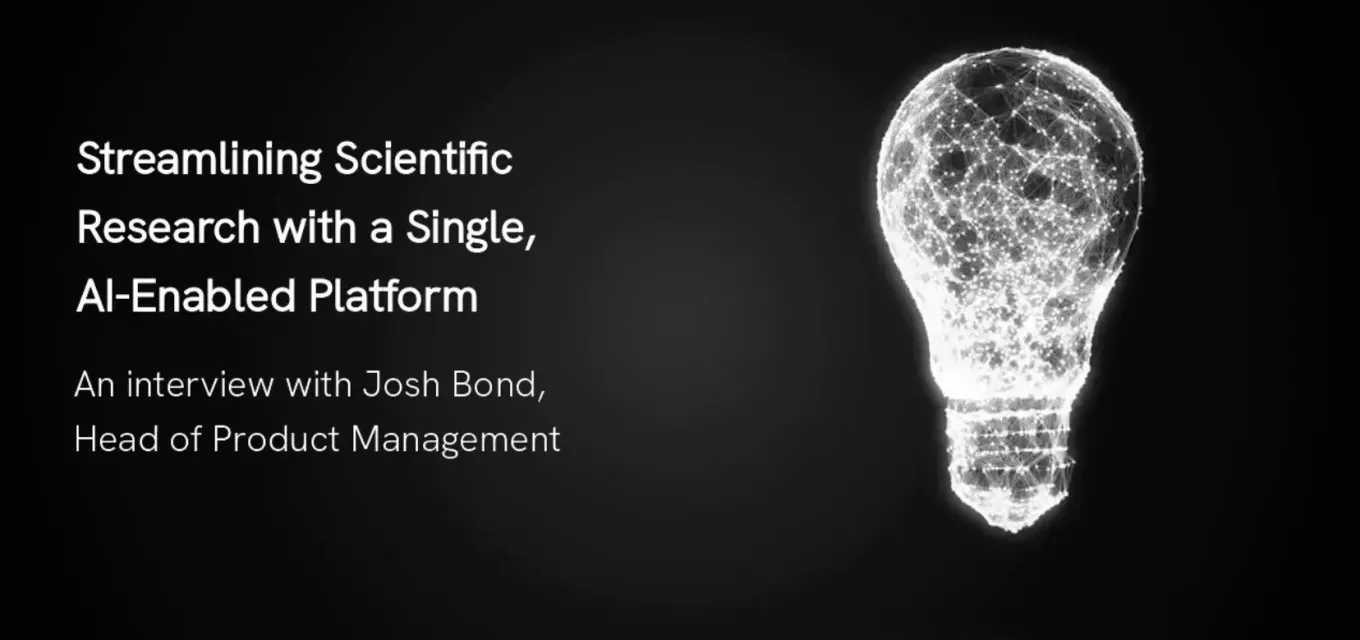Streamlining Scientific Research with a Single, AI-Enabled Platform
Today we are talking to Josh Bond, Head of Product Management, about how integrated software capabilities and artificial intelligence are shaping the way scientists conduct research. From reaching a broader range of scientific disciplines to bridging the gap between high-tech and science, this interview covers the latest trends that fuel Revvity Signals’ vision for the future of scientific research.
Q: How does Revvity Signals stay at the forefront of an industry that is constantly evolving?
A: We approach every problem by developing a deep understanding of the science behind the problem while also considering the technical challenges and opportunities. There’s just so much you can do today, whether it’s AI or cloud services, that allows you to solve problems in ways that were previously impossible. An inherent part of our Signals software ethos is bringing our engineering leadership to the forefront to brainstorm solutions that will make the lives of the scientists we serve easier.
Our current products’ technological advancements make them user-friendly and scalable. Scientists at the bench expect the same user experience from their research software as they would from applications they use at home, like Netflix, X, or Facebook. We apply the same principles to our software and have built it with the same robust technology that the high-tech industry uses.
Q: What is your vision for Revvity Signals’ software product strategy and what can researchers look forward to in the next 12 months?
We will continue to prioritize our customers by helping them solve their toughest problems. Scientists need more than generic tools, they need solutions that are specific to what they do. We are also planning advancements to the platform that will increase workflow efficiency for a broader population of scientists:
Increased flexibility for molecular biologists. They will not just record what they did in the lab, but also design how they will construct DNA strands and protein sequences.
Robust assay management for biologists. Biologists execute assays in the lab, but they also coordinate with the people who define and manage the assays. Our software offers a platform with features that support this entire network of people involved in assay management.
Enhanced data capture for formulation scientists. They will have more effective ways of capturing both the procedure and the materials that they use.
More versatility for chemists. The chemistry world is rapidly moving outside the area of small molecules, and we are adapting to this trend. Chemists will draw biopolymers while also performing advanced techniques and workflows with them.
Q: What role do AI and machine learning play in your vision to reach more scientists across diverse disciplines?
A: We’ve been doing AI for years, but here are the ways were are looking to innovate going forward:
(1) Built-in GenAI. We are integrating additional AI functions into the product to make the user experience better. For example, we want scientists to do a search on the platform that returns not only the results you searched for but also the results for related search queries (semantic search).
(2) Integration and/or embedding specific scientific models with Signals. This often involves 3rd-party models or technology. For instance, when a scientist utilizes ChemDraw® for catalyst or reaction prediction, sometimes those features make use of other tools that are embedded in the platform.
(3) AI-ready data. This has been a strength of the platform for years, but one way we are enhancing the platform is through built-in ontology support and assay management.
Our goal is to bridge the gap between scientists and AI experts. Many of our customers have AI experts, but scientists don’t have access to this expertise. As such, we believe our strategy will democratize scientific AI for the everyday user.
Q: Does AI change the decision-making process when companies adopt and deploy new software?
A: Absolutely. Part of the reason the Signals platform is so successful is that we built it using those same advanced technologies that are being leveraged by big tech companies. AI is one of those advanced technologies that offers a very robust toolset that will change the way research is conducted.
Q: What would you encourage others to consider when investing in scientific software that has AI and machine learning incorporated?
A: When you evaluate different platforms, try to understand if the software is treating AI like a “buzzword” or if the AI-enabled software capabilities will make your job easier. It’s important to ground yourself and clarify the specific requirements that you’re trying to fulfill using these technologies. Ask yourself the question, is this solving a real problem? It’s also important to lean on your vendors for solutions if you are struggling with managing models or adding product extensions. This is our wheelhouse of expertise, and we can help remove that headache while you focus on your research.
Discover how you can use our Signals platform to address your specific application needs.
Related Articles
Insider Insights: A Deep Dive Into the Revvity Signals Software Research Suite

Joshua Bond
Head of Product Management, Signals Software ResearchJosh has 20 years of software leadership experience and is responsible for the products, positioning, and strategy of Signals Software’s research portfolio. Previously, Josh worked at PegaSystems Inc. where he ran and developed an online training application, and at CambridgeSoft where he built an enterprise scientific software business. Josh started his career as a scientist at GlaxoSmithKline Pharmaceuticals and has worked alongside scientists ever since. Josh holds a Bachelor’s degree in Biology from the Massachusetts Institute of Technology and a Master’s in Technology Education from Harvard University, and resides in the Boston area with his wife and children.
